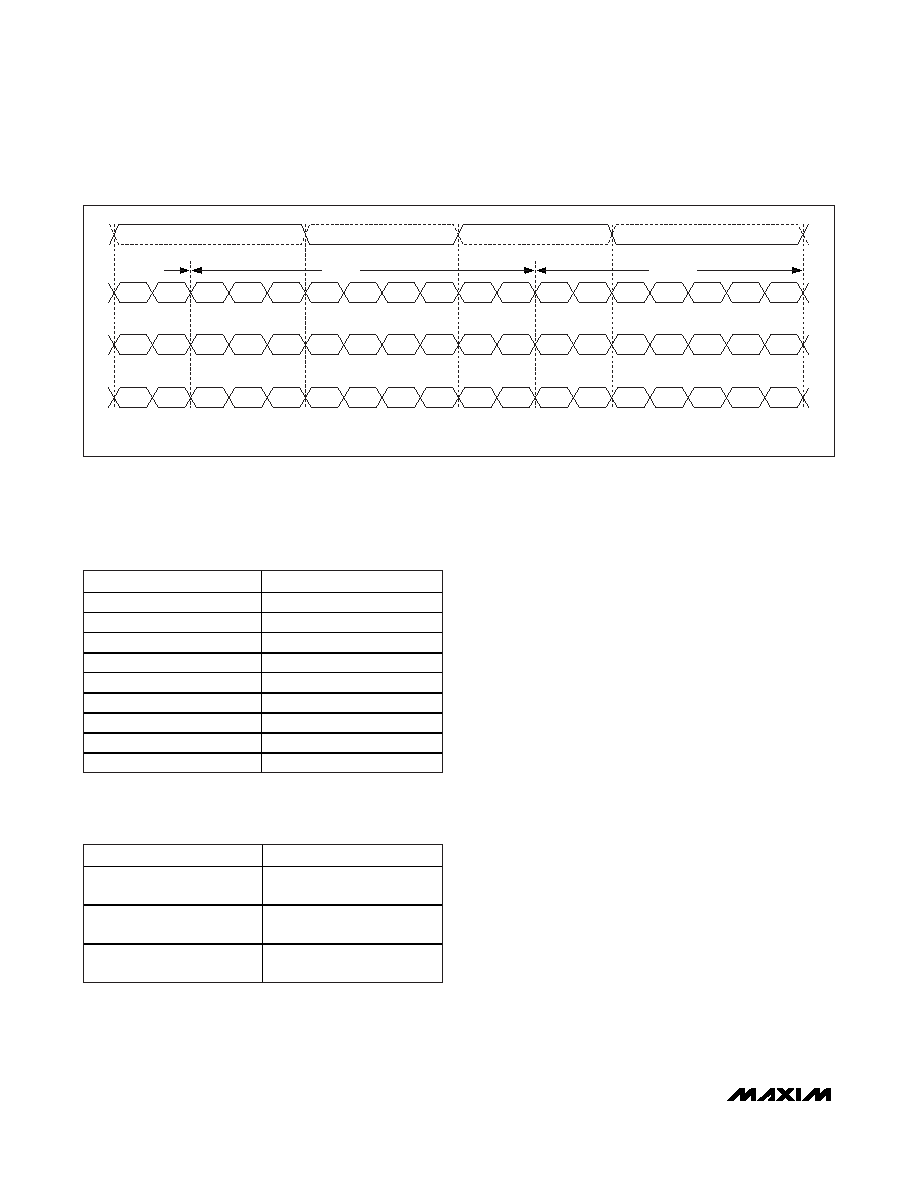- 您現(xiàn)在的位置:買賣IC網(wǎng) > PDF目錄1946 > MAX9246GUM/V+ (Maxim Integrated Products)IC DESERIALIZER 21BIT 48TSSOP PDF資料下載
參數(shù)資料
| 型號(hào): | MAX9246GUM/V+ |
| 廠商: | Maxim Integrated Products |
| 文件頁(yè)數(shù): | 6/23頁(yè) |
| 文件大?。?/td> | 0K |
| 描述: | IC DESERIALIZER 21BIT 48TSSOP |
| 標(biāo)準(zhǔn)包裝: | 39 |
| 系列: | * |
第1頁(yè)第2頁(yè)第3頁(yè)第4頁(yè)第5頁(yè)當(dāng)前第6頁(yè)第7頁(yè)第8頁(yè)第9頁(yè)第10頁(yè)第11頁(yè)第12頁(yè)第13頁(yè)第14頁(yè)第15頁(yè)第16頁(yè)第17頁(yè)第18頁(yè)第19頁(yè)第20頁(yè)第21頁(yè)第22頁(yè)第23頁(yè)

MAX9242/MAX9244/MAX9246/MAX9254
21-Bit Deserializers with Programmable
Spread Spectrum and DC Balance
To select the mid level, leave the input open, or if driven,
put the driver output in high impedance. The driver high-
impedance leakage current must be less than ±10A.
Any spread change causes a maximum delay time of
32,800 x RCIP before output data is valid. When the
spread amount is changed from ±2% to ±4% or vice-
versa, the data outputs go low for one delay time (see
Figure 13). Similarly, when the spread is changed from
no spread to ±2% or ±4%, the data outputs go low for
one delay time (see Figure 14). The data outputs contin-
ue to switch but are not valid when the spread amount is
changed from ±2% or ±4% to no spread (see Figure
15). The spread-spectrum function is also available
when the MAX9242/MAX9244/MAX9246/MAX9254 oper-
ate in non-DC-balanced mode.
Hot Swap
When the MAX9242/MAX9244/MAX9246/MAX9254 are
connected to an active serializer, they synchronize correct-
ly. The PLL control voltage does not saturate in response to
high-frequency glitches that may occur during a hot swap.
The PWRDWN input on the MAX9242/MAX9244/MAX9246/
MAX9254 does not need to be cycled when these devices
are connected to an active serializer.
PLL Lock Time
The MAX9242/MAX9244/MAX9246/MAX9254 use two
PLLs. The first PLL (PLL1) generates a 7x clock (non-DC-
balanced mode) or a 9x clock (DC-balanced mode) from
RxCLKIN_ for deserializing the LVDS inputs. The second
PLL (SSPLL) is used for spread-spectrum modulation.
During initial power-up, the PLL1 locks, and SSPLL locks
immediately after. The PLL lock times are set by an inter-
nal counter. The maximum time to lock for each PLL is
32,800 clock periods. Power and clock should be stable
to meet the lock time specification. After initialization, if
the first PLL loses lock, it locks again and then the
TxIN_, DCA_, AND DCB_ ARE DATA FROM THE SERIALIZER.
DCA0
DCB1
DCA1
DCB2
DCA2
CYCLE N + 1
CYCLE N
CYCLE N - 1
TxIN2
TxIN6
TxIN3
TxIN4
TxIN5
TxIN9
TxIN13
TxIN10
TxIN11
TxIN12
TxIN2
TxIN3
TxIN4
DCA0
TxIN5
TxIN6
DCB0
TxIN9
TxIN10
TxIN11
DCA1
TxIN12
TxIN13
DCB1
TxIN16
TxIN17
TxIN18
DCA2
TxIN19
TxIN20
DCB2
TxIN0
TxIN1
TxIN7
TxIN8
TxIN14
TxIN15
TxIN16
TxIN20
TxIN17
TxIN18
TxIN19
DCB0
RxCLKIN_
RxIN1_
RxIN0_
RxIN2_
TxIN1
TxIN8
TxIN15
TxIN0
TxIN7
TxIN14
+
-
Figure 12. Deserializer Serial Input in DC-Balanced Mode
Table 2. Modulation Rate
fRxCLKIN_ (MHz)
fM (kHz) = fRxCLKIN_ / 1016
6
5.91
8
7.87
10
9.84
16
15.75
18
17.72
20
19.68
33
32.48
34
33.46
40
39.37
Table 3. SSG Function
SSG INPUT LEVEL
FUNCTION
High
RxCLKOUT frequency spread
±4% relative to RxCLKIN_
Mid
RxCLKOUT frequency spread
±2% relative to RxCLKIN_
Low
No spread on RxCLKOUT
relative to RxCLKIN_
Note: RxOUT_ data outputs are spread because RxCLKOUT
strobes the output of the FIFO.
14
______________________________________________________________________________________
相關(guān)PDF資料 |
PDF描述 |
|---|---|
| MAX9247ETM+T | IC SERIALIZER LVDS 48-TQFN |
| MAX9248ETM+T | IC DESERIALIZER LVDS 48-TQFN |
| MAX9249GCM/V+ | IC SERIALIZER GMSL LVDS 48TQFP |
| MAX9257AGTL/V+ | IC SERDE PROG UART/I2C 40TQFN |
| MAX9257GTL+T | IC SER/DESER PROG 40-TQFN |
相關(guān)代理商/技術(shù)參數(shù) |
參數(shù)描述 |
|---|---|
| MAX9247 | 制造商:MAXIM 制造商全稱:Maxim Integrated Products 功能描述:27-Bit, 2.5MHz-to-42MHz DC-Balanced LVDS Serializer |
| MAX9247_09 | 制造商:MAXIM 制造商全稱:Maxim Integrated Products 功能描述:27-Bit, 2.5MHz-to-42MHz DC-Balanced LVDS Serializer |
| MAX9247_12 | 制造商:MAXIM 制造商全稱:Maxim Integrated Products 功能描述:27-Bit, 2.5MHz-to-42MHz DC-Balanced LVDS Serializer |
| MAX9247ECM | 制造商:MAXIM 制造商全稱:Maxim Integrated Products 功能描述:27-Bit, 2.5MHz-to-42MHz DC-Balanced LVDS Serializer |
| MAX9247ECM/V | 制造商:MAXIM 制造商全稱:Maxim Integrated Products 功能描述:27-Bit, 2.5MHz-to-42MHz DC-Balanced LVDS Serializer |
發(fā)布緊急采購(gòu),3分鐘左右您將得到回復(fù)。